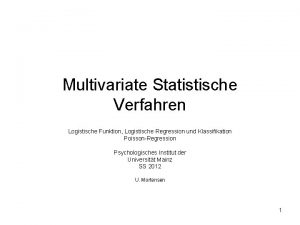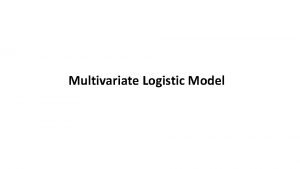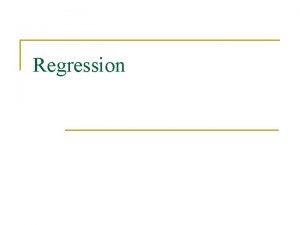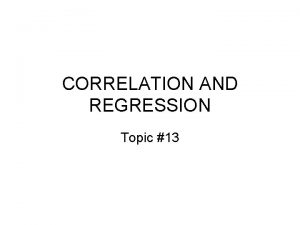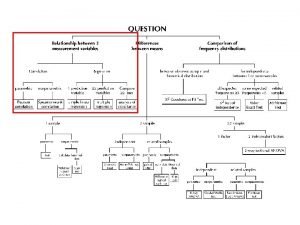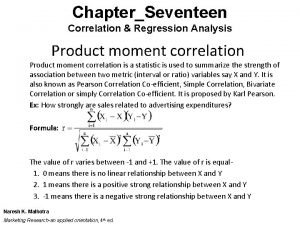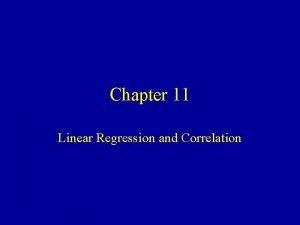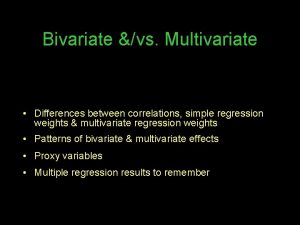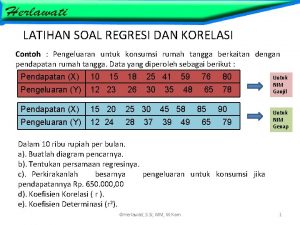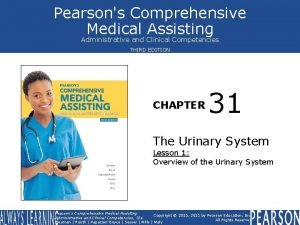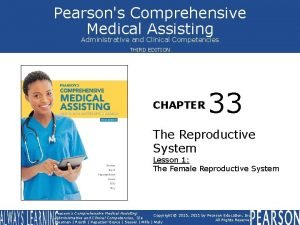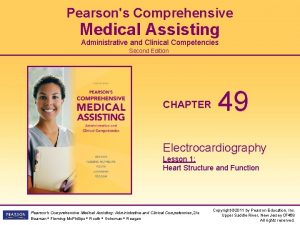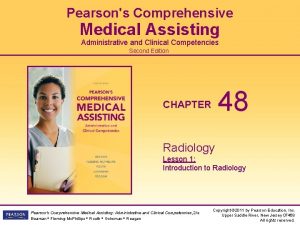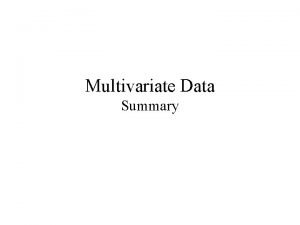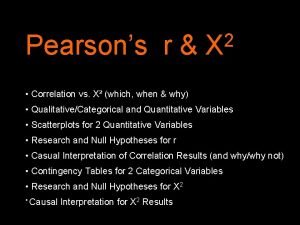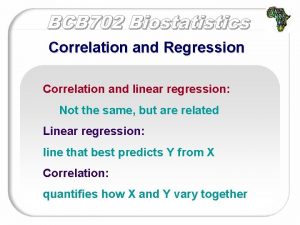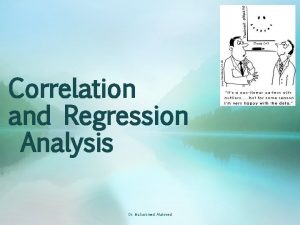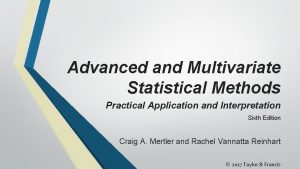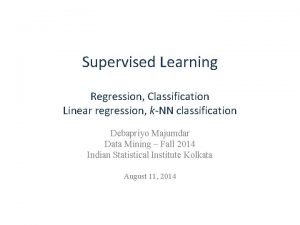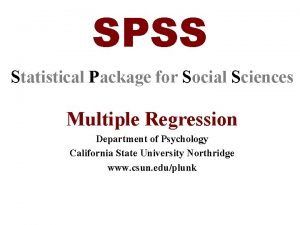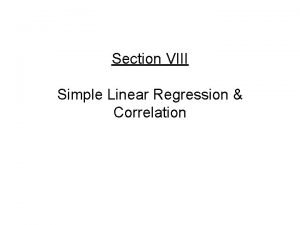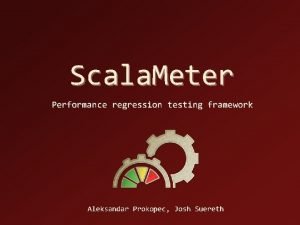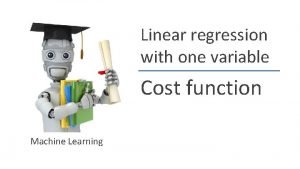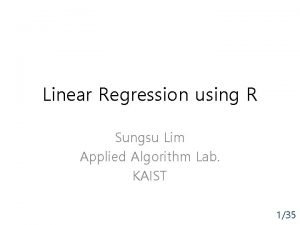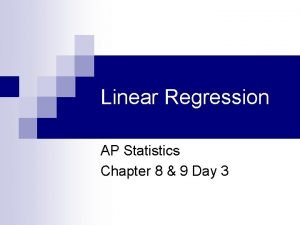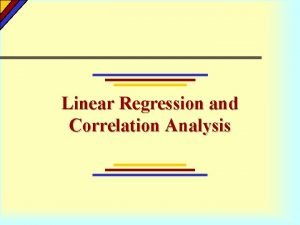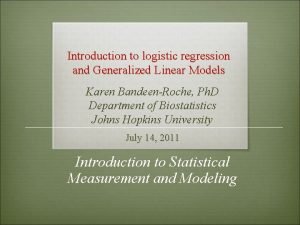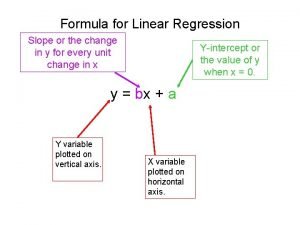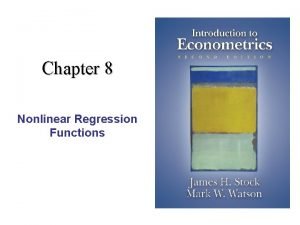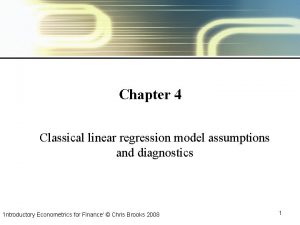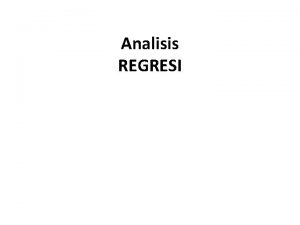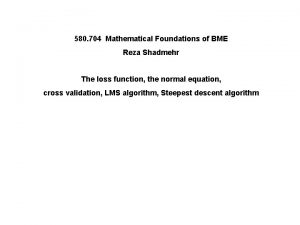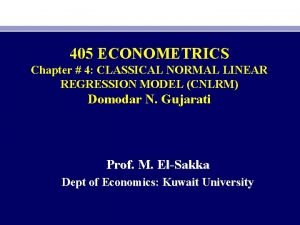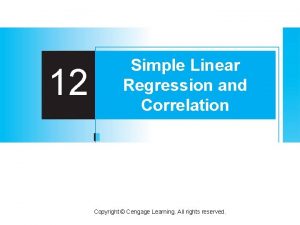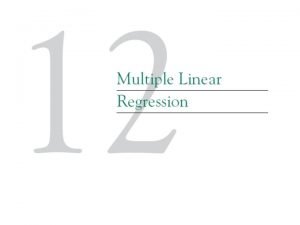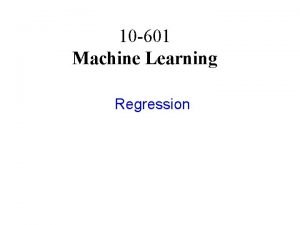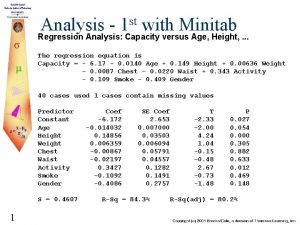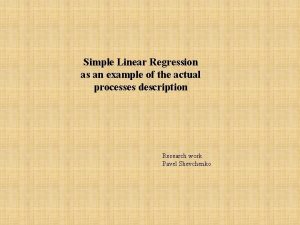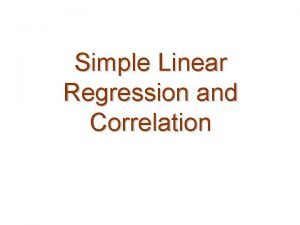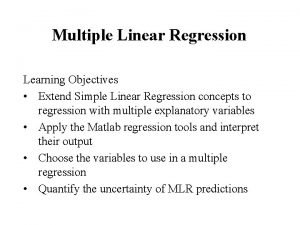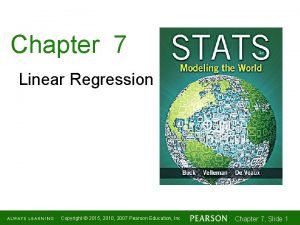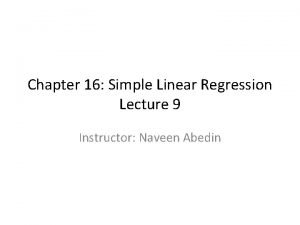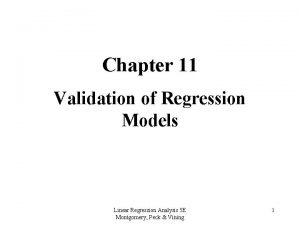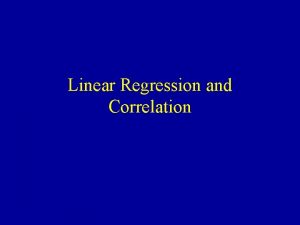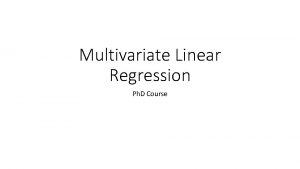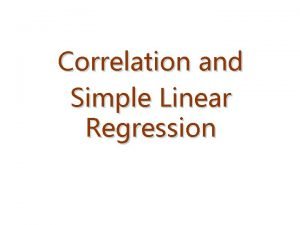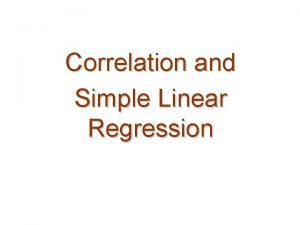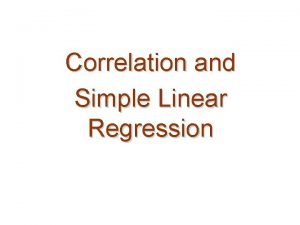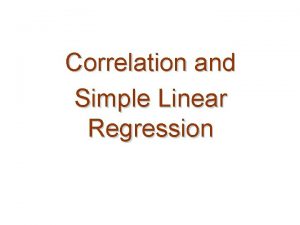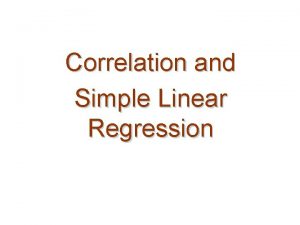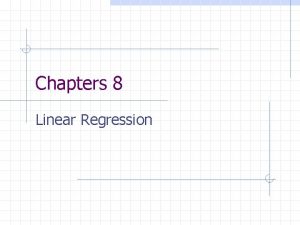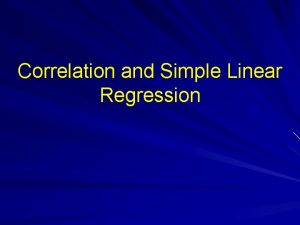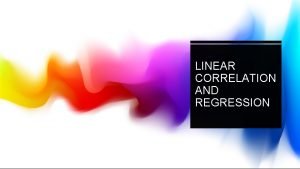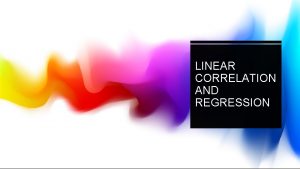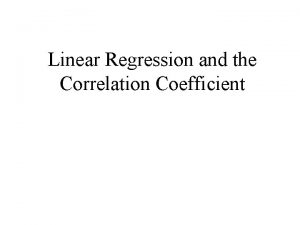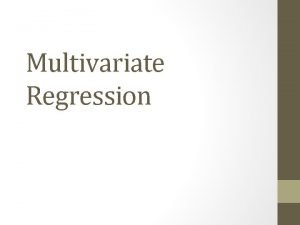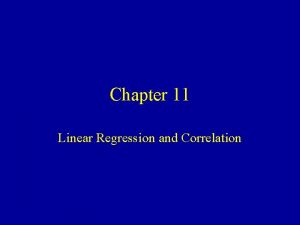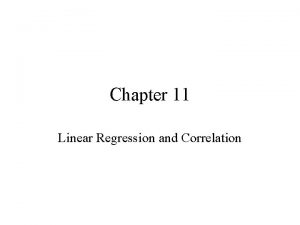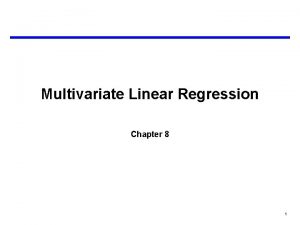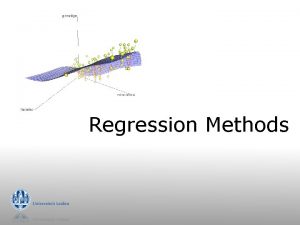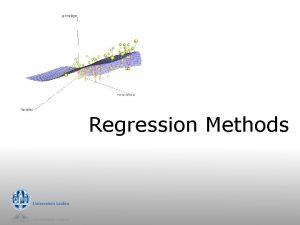Multivariate Data Summary Linear Regression and Correlation Pearsons
























































- Slides: 56

Multivariate Data Summary

Linear Regression and Correlation

Pearson’s correlation coefficient r.

Slope and Intercept of the Least Squares line

Scatter Plot Patterns r = 0. 0 r = +0. 9 r = +0. 7 r = +1. 0


Non-Linear Patterns r can take on arbitrary values between -1 and +1 if the pattern is non-linear depending or how well your can fit a straight line to the pattern

The Coefficient of Determination

An important Identity in Statistics (Total variability in Y) = (variability in Y explained by X) + (variability in Y unexplained by X)

It can also be shown: = proportion variability in Y explained by X. = the coefficient of determination

Categorical Data Techniques for summarizing, displaying and graphing

The frequency table The bar graph Suppose we have collected data on a categorical variable X having k categories – 1, 2, … , k. To construct the frequency table we simply count for each category (i) of X, the number of cases falling in that category (fi) To plot the bar graph we simply draw a bar of height fi above each category (i) of X.

Example In this example data has been collected for n = 34, 188 subjects. • The purpose of the study was to determine the relationship between the use of Antidepressants, Mood medication, Anxiety medication, Stimulants and Sleeping pills. • In addition the study interested in examining the effects of the independent variables (gender, age, income, education and role) on both individual use of the medications and the multiple use of the medications.

The variables were: 1. Antidepressant use, 2. Mood medication use, 3. Anxiety medication use, 4. Stimulant use and 5. Sleeping pills use. 6. gender, 7. age, 8. income, 9. education and 10. Role – i. iii. iv. Parent, worker, partner All variables were measured on a Categorical Scale v. viii. worker only Parent only Partner only No roles

Frequency Table for Age

Bar Graph for Age

Frequency Table for Role

Bar Graph for Role

The pie chart • An alternative to the bar chart • Draw a circle (a pie) • Divide the circle into segments with area of each segment proportional to fi or pi = fi /n

Example • In this study the population are individuals who received a head injury. (n = 22540) • The variable is the mechanism that caused the head injury (Inj. Mech) with categories: – – – MVA (Motor vehicle accident) Falls Violence Other VA (Other vehicle accidents) Accidents (industrial accident) Other (all other mechanisms for head injury)

Graphical and Tabular Display of Categorical Data. • The frequency table • The bar graph • The pie chart

The frequency table

The bar graph

The pie chart

Multivariate Categorical Data

The two way frequency table The c 2 statistic Techniques for examining dependence amongst two categorical variables

Situation • • We have two categorical variables R and C. The number of categories of R is r. The number of categories of C is c. We observe n subjects from the population and count xij = the number of subjects for which R = i and C = j. • R = rows, C = columns

Example Both Systolic Blood pressure (C) and Serum Chlosterol (R) were meansured for a sample of n = 1237 subjects. The categories for Blood Pressure are: <126 127 -146 147 -166 167+ The categories for Chlosterol are: <200 200 -219 220 -259 260+

Table: two-way frequency Systolic Blood pressure Serum Cholesterol <127 127 -146 147 -166 167+ Total < 200 117 121 47 22 307 200 -219 85 98 43 20 246 220 -259 115 209 68 43 439 260+ 67 99 46 33 245 Total 388 527 204 118 1237

Example This comes from the drug use data. The two variables are: 1. Age (C) and 2. Antidepressant Use (R) measured for a sample of n = 33, 957 subjects.

Two-way Frequency Table Percentage antidepressant use vs Age


The c 2 statistic for measuring dependence amongst two categorical variables Define = Expected frequency in the (i, j) th cell in the case of independence.

Columns 1 2 3 4 5 Total 1 2 x 11 x 21 x 12 x 22 x 13 x 23 x 14 x 24 x 15 x 25 R 1 R 2 3 x 31 x 32 x 33 x 34 x 35 R 3 4 Total x 41 C 1 x 42 C 2 x 43 C 3 x 44 C 4 x 45 C 5 R 4 N

Columns 1 2 3 4 5 Total 1 2 E 11 E 21 E 12 E 22 E 13 E 23 E 14 E 24 E 15 E 25 R 1 R 2 3 E 31 E 32 E 33 E 34 E 35 R 3 4 Total E 41 C 1 E 42 C 2 E 43 C 3 E 44 C 4 E 45 C 5 R 4 n

Justification Proportion in column j for row i overall proportion in column j 1 2 3 4 5 Total 1 E 12 E 13 E 14 E 15 R 1 2 E 21 E 22 E 23 E 24 E 25 R 2 3 E 31 E 32 E 33 E 34 E 35 R 3 4 E 41 E 42 E 43 E 44 E 45 R 4 Total C 1 C 2 C 3 C 4 C 5 n

and Proportion in row i for column j overall proportion in row i 1 2 3 4 5 Total 1 E 12 E 13 E 14 E 15 R 1 2 E 21 E 22 E 23 E 24 E 25 R 2 3 E 31 E 32 E 33 E 34 E 35 R 3 4 E 41 E 42 E 43 E 44 E 45 R 4 Total C 1 C 2 C 3 C 4 C 5 n

Multivariate Categorical data The two-way frequency table

The two-way frequency table Columns 1 2 3 4 5 Total 1 2 x 11 x 21 x 12 x 22 x 13 x 23 x 14 x 24 x 15 x 25 R 1 R 2 3 x 31 x 32 x 33 x 34 x 35 R 3 4 Total x 41 C 1 x 42 C 2 x 43 C 3 x 44 C 4 x 45 C 5 R 4 N

An Example : Table: two-way frequency Systolic Blood pressure Serum Cholesterol <127 127 -146 147 -166 167+ Total < 200 117 121 47 22 307 200 -219 85 98 43 20 246 220 -259 115 209 68 43 439 260+ 67 99 46 33 245 Total 388 527 204 118 1237

Measuring Dependence: The c 2 statistic Eij= Expected frequency in the (i, j) th cell in the case of independence. xij= observed frequency in the (i, j) th cell

Expected frequencies Eij Columns 1 2 3 4 5 Total 1 2 E 11 E 21 E 12 E 22 E 13 E 23 E 14 E 24 E 15 E 25 R 1 R 2 3 E 31 E 32 E 33 E 34 E 35 R 3 4 Total E 41 C 1 E 42 C 2 E 43 C 3 E 44 C 4 E 45 C 5 R 4 N

Example: studying the relationship between Systolic Blood pressure and Serum Cholesterol In this example we are interested in whether Systolic Blood pressure and Serum Cholesterol are related or whether they are independent. Both were measured for a sample of n = 1237 cases

Observed frequencies Systolic Blood pressure Serum Cholesterol <127 127 -146 147 -166 167+ Total < 200 117 121 47 22 307 200 -219 85 98 43 20 246 220 -259 115 209 68 43 439 260+ 67 99 46 33 245 Total 388 527 204 118 1237

Expected frequencies Systolic Blood pressure Serum Cholesterol <127 127 -146 147 -166 167+ Total < 200 96. 29 130. 79 50. 63 29. 29 307 200 -219 77. 16 104. 8 40. 47 23. 47 246 220 -259 137. 70 187. 03 72. 40 41. 88 439 260+ 76. 85 104. 38 40. 04 23. 37 245 Total 388 527 204 118 1237 In the case of independence the distribution across a row is the same for each row The distribution down a column is the same for each column


Standardized residuals The c 2 statistic

Example This comes from the drug use data. The two variables are: 1. Role (C) and 2. Antidepressant Use (R) measured for a sample of n = 33, 957 subjects.

Two-way Frequency Table Percentage antidepressant use vs Role


Calculation of c 2 The Raw data Expected frequencies

The Residuals The calculation of c 2

Example • In this example n = 57407 individuals who had been victimized twice by crimes • Rows = crime of first vicitmization • Cols = crimes of second victimization



Next Topic: Brief introduction to Statistical Packages
 Simple linear regression and multiple linear regression
Simple linear regression and multiple linear regression Survival analysis vs logistic regression
Survival analysis vs logistic regression Logistic regression vs linear regression
Logistic regression vs linear regression Linear regression vs multiple regression
Linear regression vs multiple regression Logistische funktion ableitung
Logistische funktion ableitung Linear regression spss
Linear regression spss Normal equation logistic regression
Normal equation logistic regression Which table shows no correlation
Which table shows no correlation Positive correlation versus negative correlation
Positive correlation versus negative correlation Difference between regression and correlation
Difference between regression and correlation R squared to correlation coefficient
R squared to correlation coefficient Pearson correlation coefficient
Pearson correlation coefficient Difference between regression and correlation
Difference between regression and correlation Prediction interval formula
Prediction interval formula Difference between correlation and regression
Difference between correlation and regression Multivariate vs bivariate
Multivariate vs bivariate Contoh soal regresi sederhana dan jawabannya
Contoh soal regresi sederhana dan jawabannya Pearsons exam wizard
Pearsons exam wizard Pearsons
Pearsons Pearsons
Pearsons Pearsons
Pearsons Pearson's comprehensive medical assisting
Pearson's comprehensive medical assisting Pearsons
Pearsons Pearson's r
Pearson's r Regression vs correlation
Regression vs correlation Correlation vs regression
Correlation vs regression Multivariate analysis of variance and covariance
Multivariate analysis of variance and covariance Advanced and multivariate statistical methods
Advanced and multivariate statistical methods Knn linear regression
Knn linear regression Hierarchical multiple regression spss
Hierarchical multiple regression spss Linear regression riddle b
Linear regression riddle b Scala linear regression
Scala linear regression Multiple linear regression model
Multiple linear regression model Materi regresi linear
Materi regresi linear Cost function in machine learning
Cost function in machine learning Linear regression with multiple features
Linear regression with multiple features Sum of squares
Sum of squares Ap statistics linear regression
Ap statistics linear regression Linear regression example
Linear regression example Log linear regression model
Log linear regression model F-test formula
F-test formula Log linear regression model
Log linear regression model Classical linear regression model
Classical linear regression model Sejarah regresi
Sejarah regresi Linear regression loss function
Linear regression loss function Classical normal linear regression model
Classical normal linear regression model Null hypothesis for linear regression
Null hypothesis for linear regression Multiple linear regression variance
Multiple linear regression variance Linear regression loss function
Linear regression loss function Minitab regression analysis
Minitab regression analysis Regression equation in excel
Regression equation in excel Linear regression riddle a answer key
Linear regression riddle a answer key In multiple linear regression model, the hat matrix (h) is
In multiple linear regression model, the hat matrix (h) is Linear regression gradient descent
Linear regression gradient descent Chapter 7 linear regression
Chapter 7 linear regression Linear regression lecture
Linear regression lecture Linear regression model validation techniques
Linear regression model validation techniques




